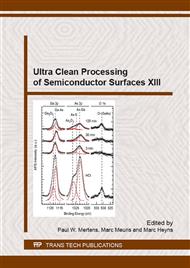p.147
p.152
p.157
p.163
p.168
p.172
p.176
p.182
p.186
Removal of Bull’s Eye Signature by Optimizing Wet Cleans Recipe
Abstract:
As the semiconductor device technology is moving toward increasingly smaller nodes, it is becoming more challenging to keep the wafers free from contamination of even smaller particles. Wet cleaning process takes a major role in keeping the wafers clean, especially in post-RIE cleans. However, as every other process, wet cleaning also contributes some defects as adders which can potentially cause significant yield killer defects. A cluster of defects, classified as incomplete etch, was observed at the center of the wafer with a wet clean recipe (CIP1) since the adders from this recipe were not allowing the etch process and rendering incomplete etch defects. In this work, we optimized this CIP1 recipe to eliminate defects with the bull’s eye signature at the wafer center and widened the process window of this type of wet cleaning process. The new recipe (CIP2) showed 100% success rate while CIP1 recipe had an occurrence of 35% failure for the bull’s eye signature on the similar quality and quantity of wafers.
Info:
Periodical:
Pages:
168-171
Citation:
Online since:
September 2016
Authors:
Price:
Сopyright:
© 2016 Trans Tech Publications Ltd. All Rights Reserved
Share:
Citation:


